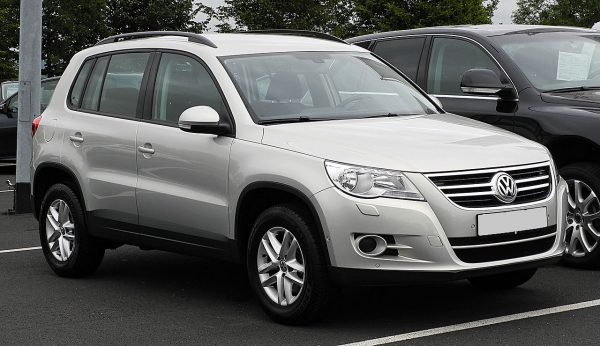
Volkswagen Tiguan: evolution, specifications, reviews
Content
The stylish compact crossover Tiguan from Volkswagen has not lost popularity for almost a decade. The 2017 model is even more style, comfort, safety and high-tech.
Volkswagen Tiguan lineup
The compact crossover VW Tiguan (from the words Tiger - "tiger" and Leguane - "iguana") first rolled off the assembly line and was presented to the general public at the Frankfurt Motor Show in 2007.
Volkswagen Tiguan I (2007–2011)
The first generation VW Tiguan was assembled on the rather popular Volkswagen PQ35 platform. This platform has proven itself in a number of models, not only Volkswagen, but also Audi, Skoda, SEAT.

Tiguan I had a laconic and, as some motorists noted, too boring design for its price. Pretty rigid contours, nondescript straight grille, plastic trim on the sides gave the car a rustic look. The interior was discreet and trimmed with gray plastic and fabric.

The VW Tiguan I was equipped with two types of gasoline engines (1,4 and 2,0 liters and 150 hp and 170 hp, respectively) or diesel (2,0 liter and 140 hp). .). All power units were paired with a six-speed manual or automatic transmission.
Volkswagen Tiguan I facelift (2011–2016)
In 2011, the corporate style of Volkswagen changed, and with it the look of the VW Tiguan. The crossover has become more like an older brother - VW Touareg. A “severe look” appeared due to LED inserts in the headlights, a embossed bumper, a more aggressive radiator grille with chrome trims, large rims (16-18 inches).

At the same time, the interior of the cabin did not undergo any special changes and remained classically laconic with high-quality fabric and plastic trim.
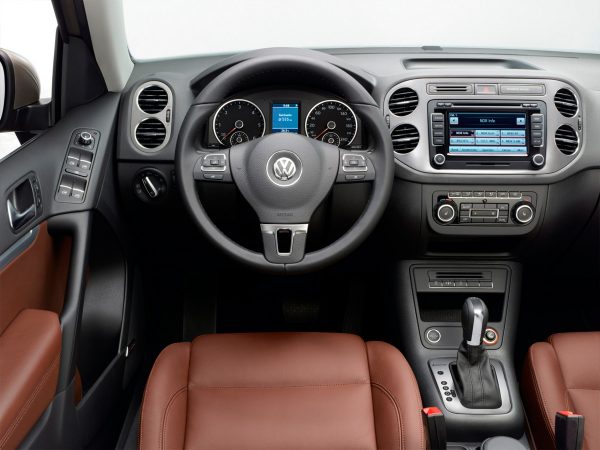
For passengers in the back seat, the new model provides cupholders and folding tables, a 12-volt outlet and even separate climate control vents.
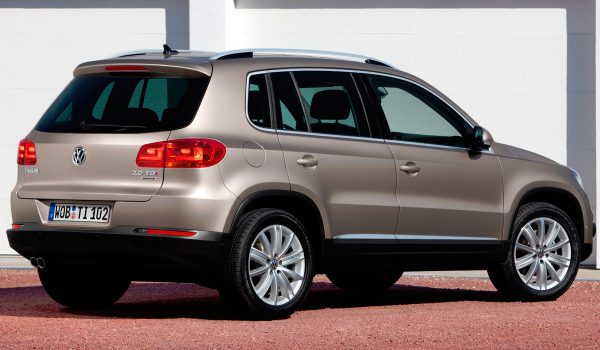
The updated Tiguan was equipped with all the engines of the previous version and a number of new power units. The line of motors looked like this:
- Petrol engine with a volume of 1,4 liters and a power of 122 liters. With. at 5000 rpm, paired with a six-speed manual gearbox. Acceleration time to 100 km / h - 10,9 seconds. Fuel consumption in mixed mode is about 5,5 liters per 100 km.
- 1,4 liter gasoline engine with two turbochargers, working with a six-speed manual gearbox or the same robot. Both front-wheel drive and all-wheel drive versions are available. Up to 100 km / h, the car accelerates in 9,6 seconds with a fuel consumption of 7-8 liters per 100 km.
- 2,0 liter petrol engine with direct injection. Depending on the boost level, the power is 170 or 200 hp. s., and the acceleration time to 100 km / h - 9,9 or 8,5 seconds, respectively. The unit is paired with a six-speed automatic transmission and consumes about 100 liters of fuel per 10 km.
- 2,0 liter petrol engine with two turbochargers capable of generating up to 210 horsepower. With. Up to 100 km / h, the car accelerates in just 7,3 seconds with a fuel consumption of 8,6 liters per 100 km.
- 2,0 liter diesel engine with 140 hp. with., paired with automatic transmission and all-wheel drive. Acceleration to 100 km / h is carried out in 10,7 seconds, and the average fuel consumption is 7 liters per 100 km.
Volkswagen Tiguan II (2016 to present)
VW Tiguan II went on sale before it was officially introduced.
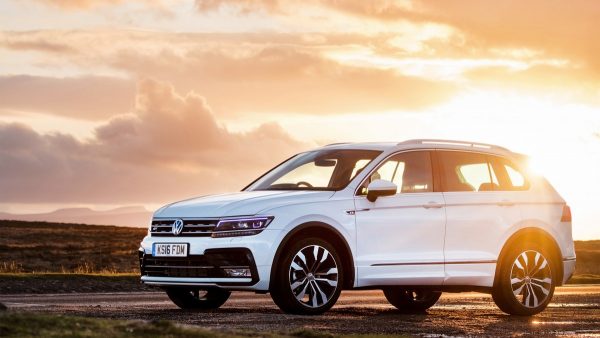
If in Europe the first comers could buy an SUV already on September 2, 2015, then the official premiere of the car took place only on September 15 at the Frankfurt Motor Show. The new Tiguan was also produced in sports versions - GTE and R-Line.

The appearance of the car has become more aggressive and modern due to the increased air intake, decorative moldings and alloy wheels. Many useful systems appeared, such as a driver fatigue sensor. It is no coincidence that in 2016 the VW Tiguan II was named the safest compact crossover.
Several types of power units are installed on the car:
- gasoline with a volume of 1,4 liters and a capacity of 125 liters. With.;
- gasoline with a volume of 1,4 liters and a capacity of 150 liters. With.;
- gasoline with a volume of 2,0 liters and a capacity of 180 liters. With.;
- gasoline with a volume of 2,0 liters and a capacity of 220 liters. With.;
- diesel with a volume of 2,0 liters and a capacity of 115 liters. With.;
- diesel with a volume of 2,0 liters and a capacity of 150 liters. With.;
- diesel with a volume of 2,0 liters and a capacity of 190 liters. With.;
- diesel with a volume of 2,0 liters and a capacity of 240 liters. With. (top version).
Table: dimensions and weights of Volkswagen Tiguan I, II
| Volkswagen Tiguan I | Volkswagen Tiguan II | |
| Length | 4427 mm | 4486 mm |
| Width | 1809 mm | 1839 mm |
| Height | 1686 mm | 1643 mm |
| Wheelbase | 2604 mm | 2681 mm |
| Weight | 1501 – 1695 kg | 1490 – 1917 kg |
Video: test drive Volkswagen Tiguan
VW Tiguan 2017: features, innovations and advantages
VW Tiguan 2017 surpasses its predecessors in many ways. Powerful and economical 150 hp engine. With. consumes about 6,8 liters of fuel per 100 km, which allows you to drive up to 700 km at one gas station. Up to 100 km / h, the Tiguan accelerates in 9,2 seconds (for the first generation model in the basic version, this time was 10,9 seconds).
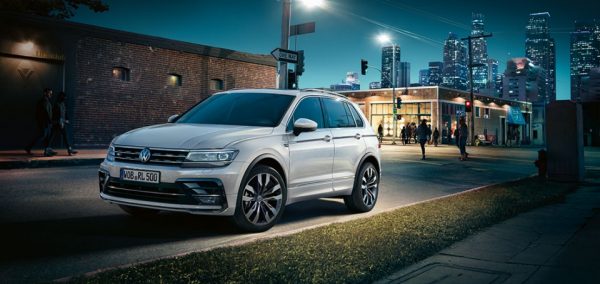

In addition, the cooling system has been improved. So, a liquid cooling circuit was added to the oil circuit, and in the new version, the turbine could be cooled autonomously after the engine was stopped. As a result, its resource has noticeably increased - it can last as long as the engine itself.
The main "chip" in the design of the new "Tiguan" was a panoramic sliding roof, and an ergonomic dashboard and a variety of auxiliary systems made it possible to get maximum driving pleasure.
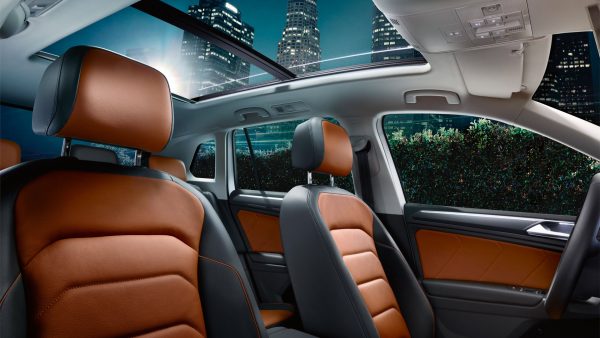

VW Tiguan 2017 is equipped with Air Care Climatronic three-season climate control system with anti-allergic filter. At the same time, the driver, front and rear passengers can independently regulate the temperature in their part of the cabin. Also of note is the Composition Color audio system with a 6,5-inch color display.
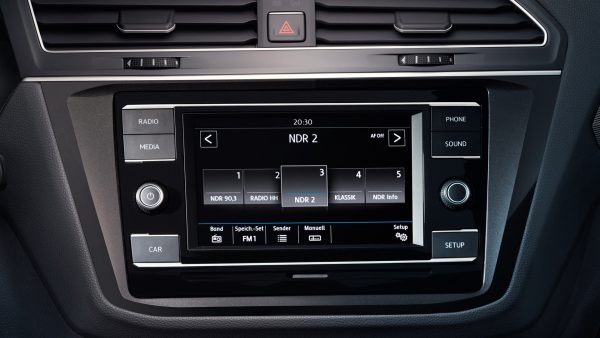

The car has an even higher level of safety than previous versions. There was a system for monitoring the distance in front and an automatic braking function, and 4MOTION permanent all-wheel drive became responsible for improved traction.
Video: adaptive cruise control and traffic jam assistant VW Tiguan 2017
How and where is VW Tiguan assembled
The main production facilities of the Volkswagen concern for the assembly of the VW Tiguan are located in Wolfsburg (Germany), Kaluga (Russia) and Aurangabad (India).
The plant in Kaluga, located in the Grabtsevo technopark, produces the VW Tiguan for the Russian market. In addition, he produces Volkswagen Polo and Skoda Rapid. The plant began operating in 2007, and on October 20, 2009, the production of VW Tiguan and Skoda Rapid cars was launched. In 2010, Volkswagen Polo began to be produced in Kaluga.
A feature of the Kaluga plant is the maximum automation of processes and minimal human participation in the assembly process - cars are assembled mainly by robots. Up to 225 thousand cars a year roll off the assembly line of the Kaluga Automobile Plant.
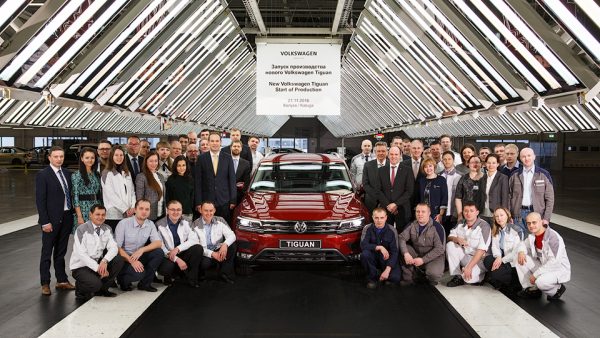

Production of the updated VW Tiguan 2017 was launched in November 2016. Especially for this, a new body shop with an area of 12 m was built2, updated painting and assembly shops. Investments in the modernization of production amounted to about 12,3 billion rubles. The new Tiguans became the first Volkswagen cars produced in Russia with a glass panoramic roof.
VW Tiguan Engine Choice: Gasoline or Diesel
When choosing a new car, the future car owner must make a choice between a gasoline and a diesel engine. Historically, gasoline engines are more popular in Russia, and diesel motorists are treated with distrust and even apprehension. Nevertheless, the latter have a number of undoubted advantages:
- Diesel engines are more economical. Diesel fuel consumption is 15–20% lower than gasoline consumption. Moreover, until recently, diesel fuel was much cheaper than gasoline. Now the prices for both types of fuel are equal.
- Diesel engines are less harmful to the environment. Therefore, they are widely popular in Europe, where much attention is paid to environmental problems and, in particular, to harmful emissions into the atmosphere.
- Diesels have a longer resource compared to gasoline engines. The fact is that in diesel engines a more durable and rigid cylinder-piston group, and diesel fuel itself partly acts as a lubricant.
On the other hand, diesel engines also have disadvantages:
- Diesel engines are noisier due to the high combustion pressure. This problem is solved by strengthening sound insulation.
- Diesel engines are afraid of low temperatures, which significantly complicates their operation in the cold season.
Historically, gasoline engines have been considered more powerful (although modern diesels are almost as good as them). At the same time, they consume more fuel and work better at low temperatures.
You have to start with a goal. What do you want: get a buzz from the car or save money? I understand that it is both at the same time, but it does not happen. What runs? If less than 25-30 thousand per year and mainly in the city, then you will not get tangible savings from a diesel engine, if more, then there will be savings.
When deciding to buy a new car, it is advisable to sign up for a test drive - this will help you make the best choice.
Volkswagen Tiguan owner reviews
VW Tiguan is a very popular car in Russia. In October 2016 alone, 1451 units were sold. VW Tiguan accounts for about 20% of Volkswagen sales in Russia - only VW Polo is more popular.
Owners note that Tiguans are quite comfortable and easy to drive cars with good cross-country ability, and the latest models, in addition to this, have an attractive design.
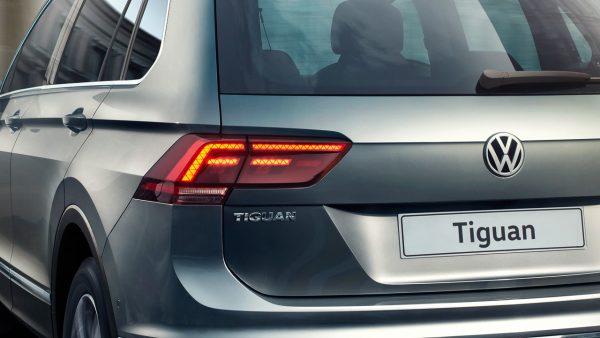

As the main drawback of the VW Tiguan of the Kaluga assembly, which are the majority on domestic roads, motorists highlight insufficient reliability, pointing to frequent malfunctions of the piston system, problems with the throttle, etc. “Good work by German engineers and poor work by Kaluga hands,” - the owners chuckle bitterly, who are not entirely lucky with the “iron horse”. Other shortcomings include:
- high prices for additional equipment and maintenance;
- quite stiff suspension;
- relatively high fuel consumption.
The cross-country ability for the SUV is amazing. Snow above the hub, and rushing. To the cottage after any snowfall is free. In the spring, sleet suddenly fell. Went to the garage, started up and drove out.
A small trunk, the fuel sensor is not very good, in severe frost it gives an error and blocks the steering wheel, the cable of the multifunction steering wheel is torn, in general the model is not reliable ...
German Russian assembly - it seems that there are no serious complaints, but somehow it is assembled crookedly.
VW Tiguan is a stylish, comfortable and reliable car, whose popularity in Russia has increased significantly after the launch of the Volkswagen plant in Kaluga. When buying, you can choose the type and power of the engine and supplement the basic package with numerous options.


